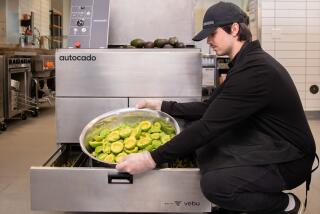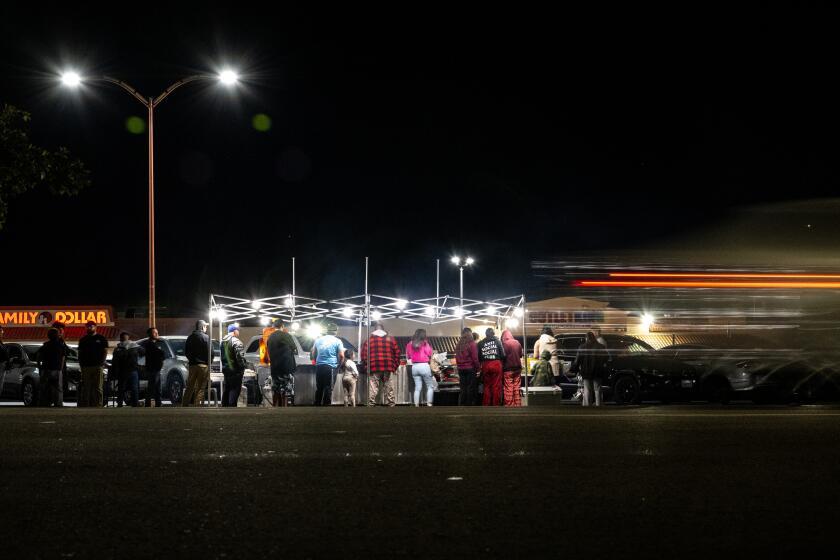Automation Machinery Makers Helping Firms Compete
- Share via
Dieter Kuntz’s eyes sparkle as he talks about his creations. “Making a big machine is fun,” says the master toolmaker, his German accent thinned by 32 years in Orange County.
“It is like a birth, this bringing of something from nothing. The high you get when it’s up and running is unbelievable.”
For more than a year now, Kuntz has been on an almost continuous high, and there are no signs that he will have to come down anytime soon.
Kuntz, founder of Kuntz Mfg. Co. Inc. in Santa Ana, designs and builds automated specialty assembly machines. And automation is enjoying a boom in several industries that Kuntz serves--particularly medical products and electronics.
The boom is being felt across the country, automation specialists say, but nowhere are manufacturers turning to automated production with any more fervor than in Orange County, where automation for many companies has become a matter of survival.
The county is a hotbed of small and medium-size high-technology firms, most of them either still developing their first products or just beginning to produce and market.
Labor Supply Scarce
And their need to price competitively with products that are made with lower labor costs overseas while providing the high level of quality demanded by customers provides a powerful argument for automation.
Further, the county’s extremely low unemployment rate, high housing costs and congested traffic situation add to the pressures that are driving the automation binge.
Many manufacturers no longer feel assured that a manual production line will work in Orange County.
They complain that they cannot find enough people who are willing to labor for assembly workers’ wages. A paycheck of $250 to $400 a week, less taxes, simply isn’t sufficient to cover both housing and groceries in much of the county.
And while $6 to $10 an hour is all most companies can afford to pay assembly workers and remain competitive, it no longer compensates a commuting worker for the two hours or more a day it takes to drive in from Riverside or Los Angeles.
“We made the decision to automate in order to survive and be competitive,” said Mike Varner, president of ICU Medical Inc. of Mission Viejo.
“For us, the essence of automation is that low-paid assembly workers are hard to find in Orange County, and they are in such demand that they can pick and choose the kinds of jobs they will take. There is a lot of turnover, and that costs a company money.”
Last summer, when ICU opened a new plant in Mission Viejo to begin manufacturing specialized intravenous needles and blood-collection systems designed to protect health-care workers against infectious diseases, the company decided to add 10 workers to its payroll.
It had to go through agencies that supplied temporary employees just to get enough assembly workers to try out. “Even then it took us two weeks,” Varner said. “People just wouldn’t show up.”
It is a dramatic change from just a year or two ago, when automated production equipment salesmen often couldn’t get through to a potential client’s engineering department.
“Half the time, I’d get turned down by the receptionist,” said Roger Kuntz, a vice president and marketing specialist at Kuntz Mfg.
“They’d hear ‘automation’ and immediately think we were out to replace all the people that worked there. They’d tell us that no one was in or that the company didn’t believe in automation and never put us through to the production engineer.”
Very Little Advertising
But those days are disappearing.
Kuntz says business at his company, which designs and manufactures one-of-a-kind specialty production machines, is at its highest level ever and promises to continue growing--despite the company’s low profile. The first advertising the 14-year-old firm ever did was in a regional trade magazine less than nine months ago. “It’s all been done with word-of-mouth so far,” said Kuntz.
The company has 15 employees--including all four members of the Kuntz family--and has grown to become one of the largest of a small cadre of West Coast automation machine builders.
A nearby competitor, 16-year-old Charles Wyle Engineering in Torrance, does about the same volume of business--about $5 million a year--over a wider swath of the country.
Founder Charles Wyle agrees with Kuntz that business has never been better. “Since last October,” he said, “the number of requests for quotations (from potential clients) is up about 200%. . . . We are being inundated.”
Wyle said industry in the United States “has been beaten (by foreign producers) because of the emphasis on immediate results rather than in investing for the future. . . . But we are seeing some of our larger clients realizing this and bringing back work from abroad to do it here automatically, not only to save on labor but to produce uniform, high-quality products.”
And small companies that previously did not consider automation because of the high capital outlay--the average cost of machines produced by Kuntz or Wyle is $500,000--also are turning to automation, Wyle said, to become competitive.
Small companies all across the nation “are stepping up to automation because it is a necessity if you are to survive in today’s environment,” said Mark Samples, manufacturing director for Quest Medical in Dallas. “We knew that to be a player, we had to find a way to lower the cost of manufacturing while improving quality.”
ICU, said Varner, had only $5 million in sales last year, but spent about $2 million to automate the most labor-intensive portion of its assembly process. Company officials “considered going to Mexico, and we looked at production in Asia,” he said, “but we decided that through the right coordination of people and automation, we can be a high-quality manufacturer right here in the United States. Going offshore can cut labor costs, but it adds other costs in quality assurance and communication.”
Small Firms Were Left Out
It wasn’t long ago that automation meant highly specialized equipment that made only a single product or part but made it day in and day out. “It was only justified by long production runs of standardized products,” said Bela Gold, professor of technology and management at the Claremont Graduate School.
“Under those conditions, small firms had no way of using automation because most of them make a variety of products in relatively small runs.”
But computerization has changed all that, Gold said, making it possible to program so-called flexible production machinery to produce a variety of parts or products.
That kind of automation, he said, “cuts labor costs and gives you relatively continuous quality control,” a critical item in many of the high-tech businesses now turning to automation--especially companies that make complex electronic parts and medical supplies and diagnostic kits.
Machines, if designed, built and programmed properly, can continue churning out identical parts for weeks on end. Humans, no matter how motivated and well-paid, have an attention span that does not hold up well under repetitive tasks.
Gold, a specialist in automated production systems, said that their acceptance nationally has been “disappointingly slow” but adds that industries like electronics and medical products have adopted automation more rapidly.
Southern California is a major center for automation, he said, largely because these industries are concentrated on the West Coast and in the Northeast.
The region’s low unemployment rate also helps, said R.T. Johnson, a professor of mechanical engineering at the University of Missouri’s campus at Rolla and director of the Institute for Flexible Manufacturing and Industrial Automation.
“In the Midwest, automation at small companies is not as big an item as on the West Coast because the pressures are not the same,” he said. “There are lots of small communities here with . . . relatively low-priced labor pools” that make it less cost-effective to automate.
In his pitches to prospective customers, Roger Kuntz says that automated machinery should pay for itself through savings in labor and other costs in about two years.
No Employees Lost
That doesn’t mean, however, that the savings should come from lopping off a lot of jobs.
At Quest Medical, a machine built by Kuntz Mfg. increased production output by 40%, said manufacturing director Samples. “And we put in the machine without losing one employee,” he said.
At VLI in Irvine, manufacturer of the Today brand contraceptive sponge, officials have credited systems designed and built by Kuntz with a sixfold increase in production capacity.
And at ICU, said company president Varner, “Kuntz’s machines will allow us to reduce (assembly) manpower needs by about 70% and greatly improve the quality of our product.”
In some cases, companies looking toward automation will plan for it by using only temporaries on the assembly process that is targeted for mechanization.
Varner said ICU “won’t be laying off a single person because of automation. We have planned out the sequence of events so our manpower is at the proper level. We are hiring now only through temporary agencies.”
Rain Bird Consumer Products Manufacturing Corp. in Azusa used temporaries on its eight-person, pop-up sprinkler assembly line for more than two years before automating with a machine that has increased productivity and quality control and requires seven fewer assembly workers.
“Automation allows you to eliminate the tedious jobs,” said ICU’s Varner. “And then when you hire permanent people, you get them involved in better paying and more satisfactory jobs.”
THREE AUTOMATION SYSTEMS The three basic types of manufacturing automation systems as described by Dr. R.T. Johnson, professor of mechanical engineering and director of the Institute of Flexible Manufacturing and Industry Automation at the Rolla campus of the University of Missouri:
Hard automation is the oldest and most well developed. Economical for large production runs. You build a dedicated assembly line that makes one product, rapidly, but won’t do anything else.
Flexible automation is a system, or a single machine, that can be easily altered to change products. Involves computer-controlled machines and careful planning of production runs. With flexible manufacturing you could manufacture five or 50 separate parts in several sizes with one installation, simply by changing the programming of the machines. The disadvantage is slower production volume.
Computer integrated manufacturing is flexible automation tied into the rest of a company’s operations via computer communication and a business philosophy that says the company is going to use it--from top to bottom. There aren’t many of these CIM systems in the United States.
More to Read
Inside the business of entertainment
The Wide Shot brings you news, analysis and insights on everything from streaming wars to production — and what it all means for the future.
You may occasionally receive promotional content from the Los Angeles Times.










